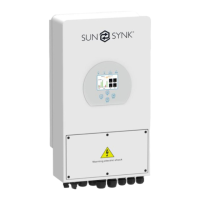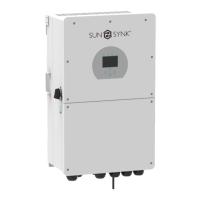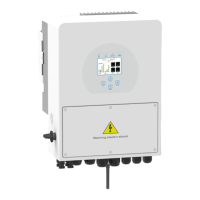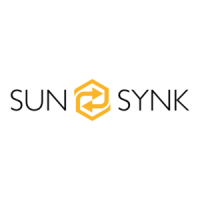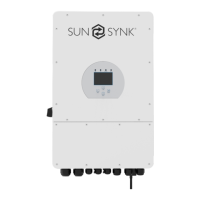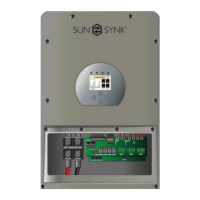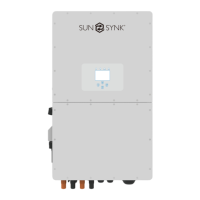Do you have a question about the SunSynk SYNK-7K-SG05LP1 and is the answer not in the manual?
General safety precautions and user responsibilities for the inverter.
Explanation of various safety symbols and their meanings for hazard identification.
Detailed safety instructions for installation, operation, and maintenance.
Guidelines for the proper disposal of the inverter and accessories.
An overview of the Sunsynk Ecco Hybrid Inverter's features and capabilities.
Dimensions and physical specifications of the inverter unit.
Detailed interactive, compatible, configurable, secure, and application-specific features.
Illustrates the typical system setup and components for the inverter.
Specifications for battery input, PV input, and AC output parameters.
Details on efficiency ratings, protection features, and compliance standards.
General operational parameters like temperature range, noise, weight, and warranty.
List of components included in the inverter package for installation.
Guidelines for selecting a mounting area and instructions for physically mounting the inverter.
Requirements and specifications for connecting the battery to the inverter.
Explanation of the purpose and connections for various function ports on the inverter.
Recommendations for DC battery protection and steps for connecting a lithium battery.
Diagram and explanation for connecting the battery temperature sensor.
Instructions for connecting AC power, breaker recommendations, and surge protector details.
Instructions, selection criteria, and wiring for PV modules.
PV protection diagram and steps for installing the CT coil for zero export functionality.
Meter connection diagram and mandatory earth connection procedures for safety.
Wiring diagrams for grid systems and typical diesel generator connection.
Wiring diagrams and configuration for single and three-phase parallel inverter systems.
Procedure for turning the inverter on/off, overview of display, LEDs, and function buttons.
Visual guide illustrating navigation through the inverter's LCD menus.
Description of Home and Status Pages, displaying system information and data.
Explanation of the System Flow Page, showing power generation and distribution.
Access to basic setup options like time, date, company name, and display settings.
Configuration of battery types, charging, discharge, and generator interaction.
Steps to set up lithium batteries, check communication, and view compatible models.
Setting specific times for battery cycles and configuring operating modes for export control.
Configuring grid supply type, frequency, parameters, voltage/frequency protection, and power factor.
Configuring multi-inverter parallel operation, FAQs, DRMs, wind turbines, and auxiliary loads.
Configuration of auxiliary load modes, smart load features, and micro inverter input.
Description of basic operation and operation with a generator, showing system connections.
Description of smart load and AC couple operation modes with system diagrams.
List of alarm codes, their occurrence, and initial troubleshooting solutions.
A complete list of fault information and the corresponding instructions for resolution.
Procedures for safe start-up/shutdown and essential checks for inverter commissioning.
Understanding system modes, parallel settings, and common fault codes.
Explanation of GDFI fault related to solar PV impedance detection before grid connection.
Routine maintenance tasks for the inverter, including cleaning cooling fans and air ducts.
Pinout details for CAN, RS485, and RS232 connections on the battery and inverter sides.
Guidelines for using Residual Current Devices (RCDs) with the inverter for safety.
General safety precautions and user responsibilities for the inverter.
Explanation of various safety symbols and their meanings for hazard identification.
Detailed safety instructions for installation, operation, and maintenance.
Guidelines for the proper disposal of the inverter and accessories.
An overview of the Sunsynk Ecco Hybrid Inverter's features and capabilities.
Dimensions and physical specifications of the inverter unit.
Detailed interactive, compatible, configurable, secure, and application-specific features.
Illustrates the typical system setup and components for the inverter.
Specifications for battery input, PV input, and AC output parameters.
Details on efficiency ratings, protection features, and compliance standards.
General operational parameters like temperature range, noise, weight, and warranty.
List of components included in the inverter package for installation.
Guidelines for selecting a mounting area and instructions for physically mounting the inverter.
Requirements and specifications for connecting the battery to the inverter.
Explanation of the purpose and connections for various function ports on the inverter.
Recommendations for DC battery protection and steps for connecting a lithium battery.
Diagram and explanation for connecting the battery temperature sensor.
Instructions for connecting AC power, breaker recommendations, and surge protector details.
Instructions, selection criteria, and wiring for PV modules.
PV protection diagram and steps for installing the CT coil for zero export functionality.
Meter connection diagram and mandatory earth connection procedures for safety.
Wiring diagrams for grid systems and typical diesel generator connection.
Wiring diagrams and configuration for single and three-phase parallel inverter systems.
Procedure for turning the inverter on/off, overview of display, LEDs, and function buttons.
Visual guide illustrating navigation through the inverter's LCD menus.
Description of Home and Status Pages, displaying system information and data.
Explanation of the System Flow Page, showing power generation and distribution.
Access to basic setup options like time, date, company name, and display settings.
Configuration of battery types, charging, discharge, and generator interaction.
Steps to set up lithium batteries, check communication, and view compatible models.
Setting specific times for battery cycles and configuring operating modes for export control.
Configuring grid supply type, frequency, parameters, voltage/frequency protection, and power factor.
Configuring multi-inverter parallel operation, FAQs, DRMs, wind turbines, and auxiliary loads.
Configuration of auxiliary load modes, smart load features, and micro inverter input.
Description of basic operation and operation with a generator, showing system connections.
Description of smart load and AC couple operation modes with system diagrams.
List of alarm codes, their occurrence, and initial troubleshooting solutions.
A complete list of fault information and the corresponding instructions for resolution.
Procedures for safe start-up/shutdown and essential checks for inverter commissioning.
Understanding system modes, parallel settings, and common fault codes.
Explanation of GDFI fault related to solar PV impedance detection before grid connection.
Routine maintenance tasks for the inverter, including cleaning cooling fans and air ducts.
Pinout details for CAN, RS485, and RS232 connections on the battery and inverter sides.
Guidelines for using Residual Current Devices (RCDs) with the inverter for safety.
| Model | SYNK-7K-SG05LP1 |
|---|---|
| Category | Inverter |
| Rated Power | 7kW |
| Number of MPPT Trackers | 2 |
| Number of MPPTs | 2 |
| Max. Output Current | 32 A |
| Battery Voltage | 48 V |
| Max. Charging Current | 100 A |
| Max. Discharging Current | 100 A |
| Protection | IP65 |
| Weight | 35kg |
| Protection Class | IP65 |
| Max PV Input Power | 9 kW |
| MPPT Voltage Range | 120V-430V |
| Max AC Output Power | 7000 W |
| Nominal AC Voltage | 230 V |
| AC Frequency | 50Hz/60Hz |
| Communication | RS485, Wi-Fi |
| Dimensions | 422mm x 702mm x 281mm |
| Cooling Method | Natural cooling |
